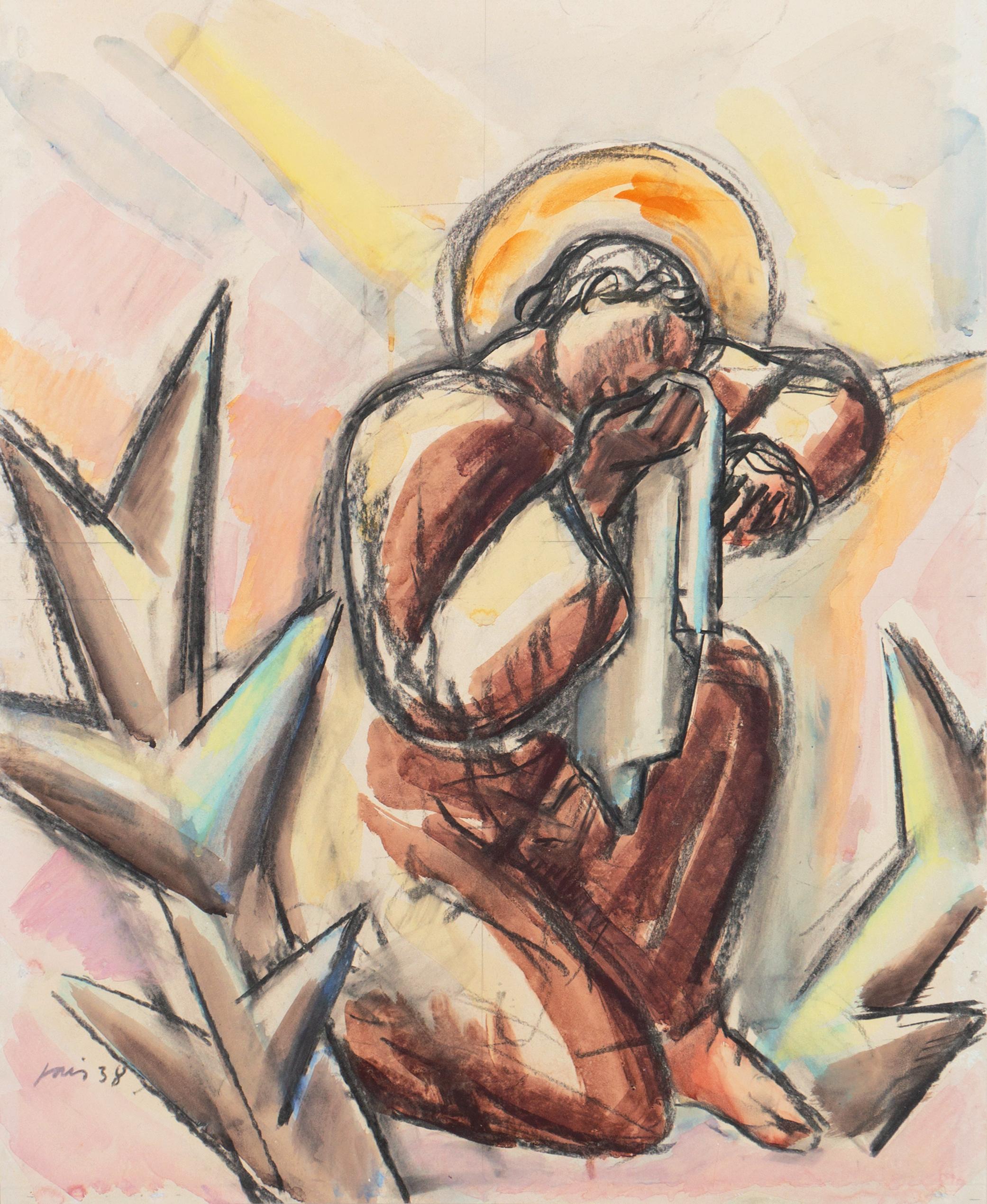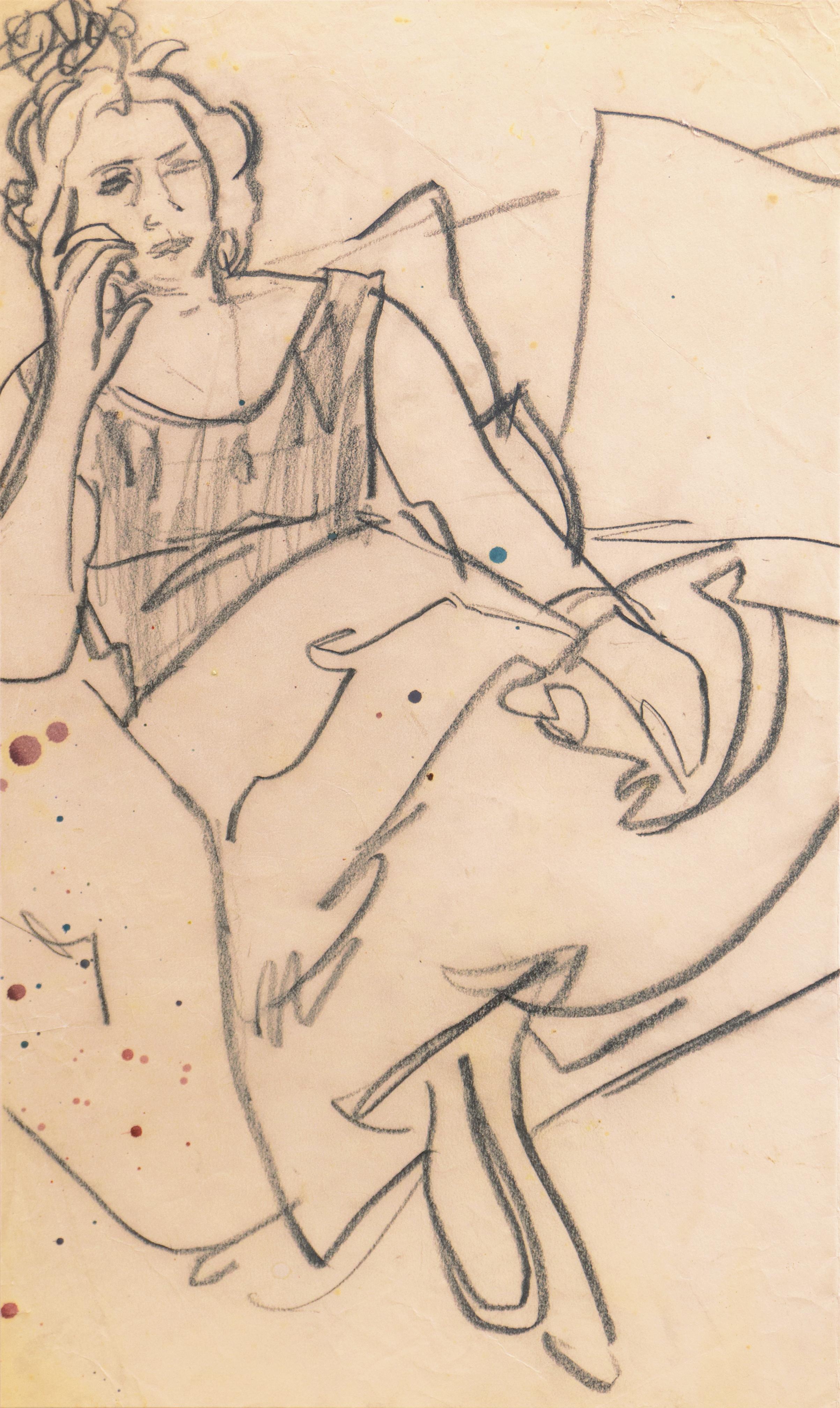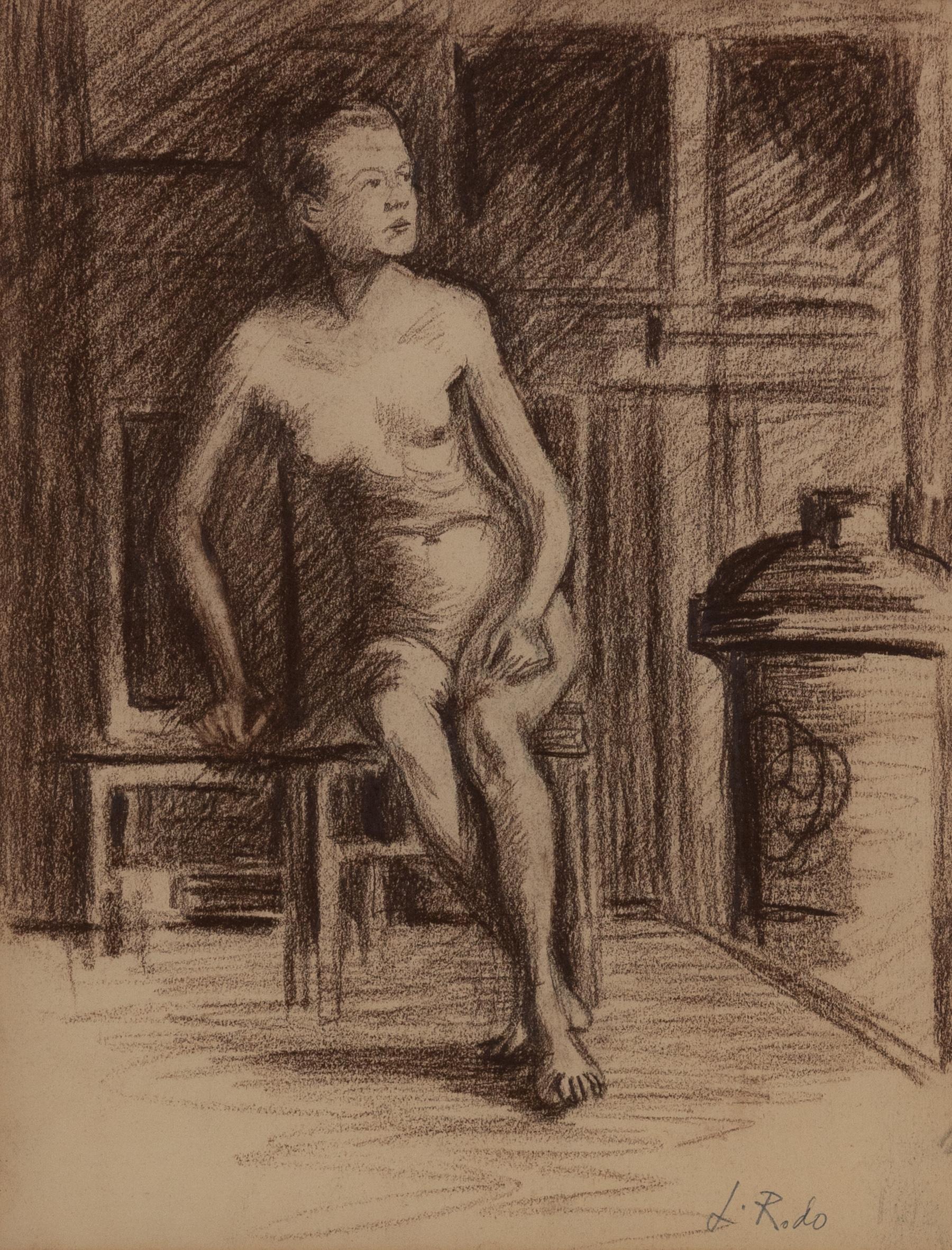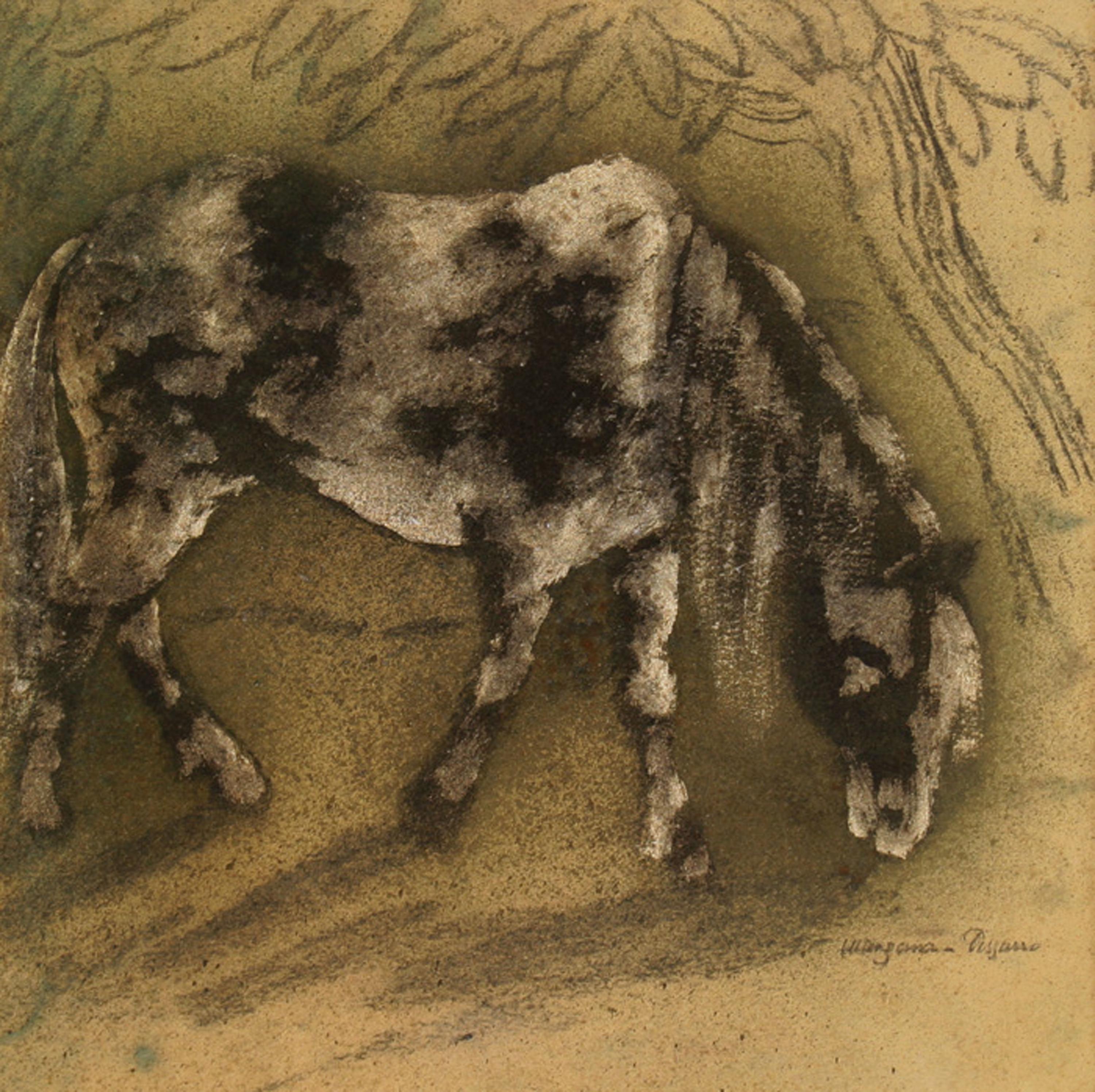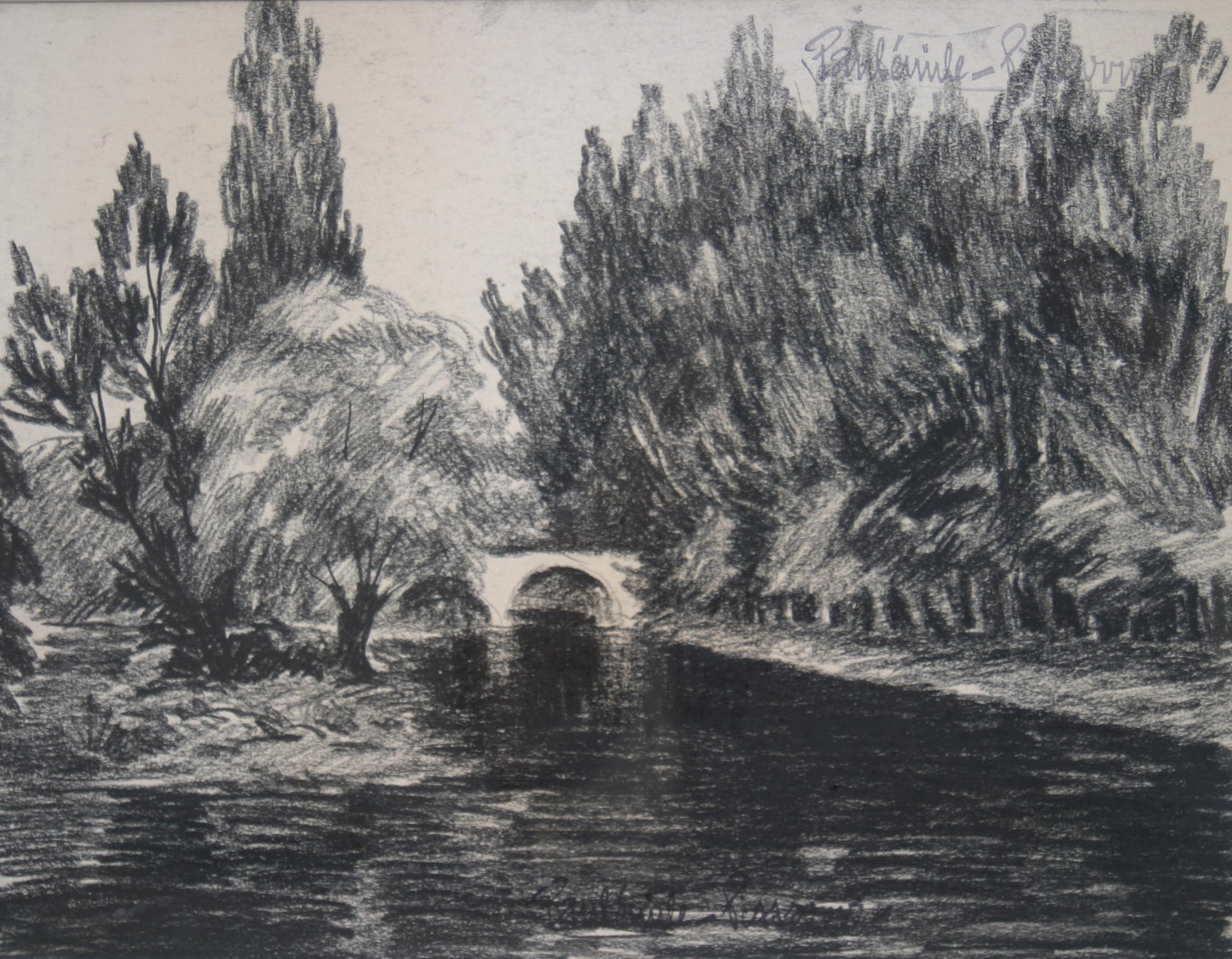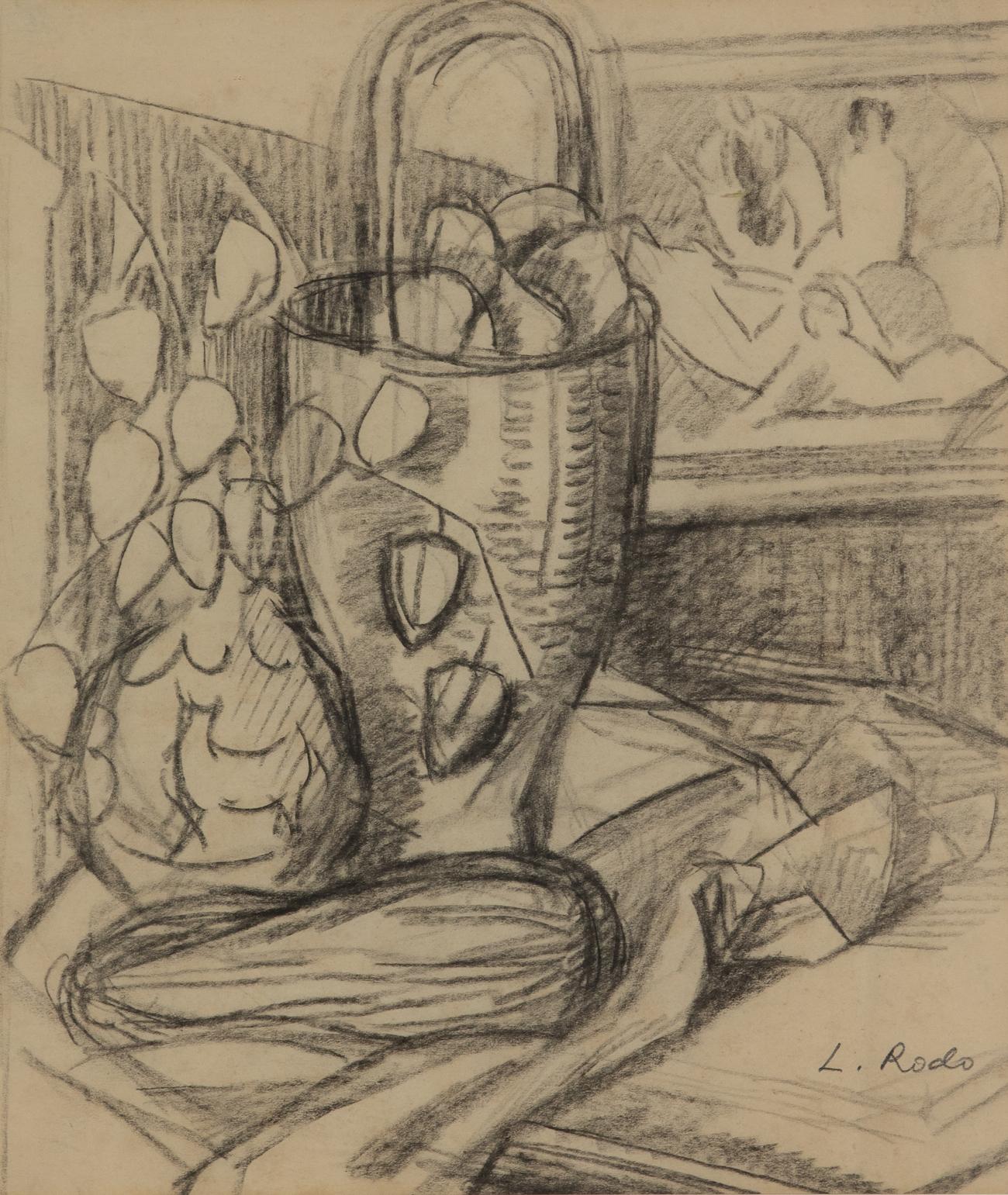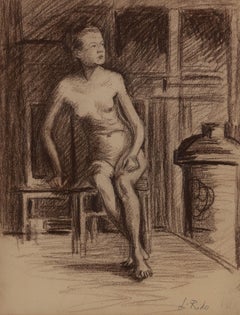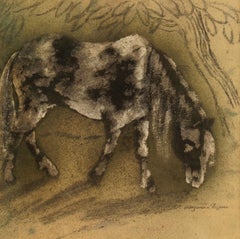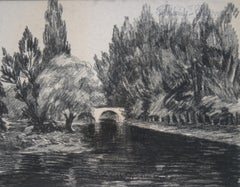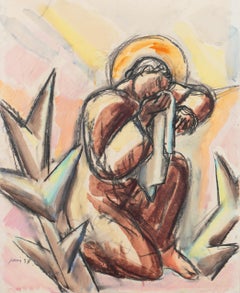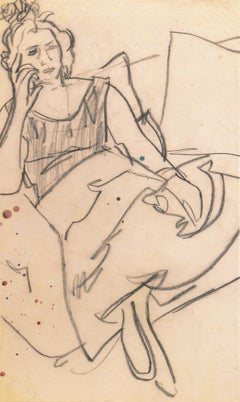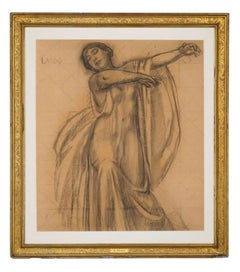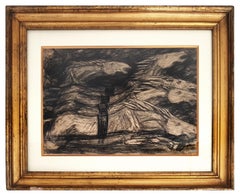Items Similar to Le Ramassage de Foin by Paulémile Pissarro - Work on paper
Want more images or videos?
Request additional images or videos from the seller
1 of 9
Paul Emile PissarroLe Ramassage de Foin by Paulémile Pissarro - Work on paper
About the Item
Le Ramassage de Foin by Paulémile Pissarro (1884-1972)
Charcoal on paper
26 x 33 cm (10 ¹/₄ x 13 inches)
Signed lower left, Paulémile- Pissarro-
This work is accompanied by a certificate of authenticity from Lélia Pissarro.
Artist biography
Paulémile Pissarro, Camille Pissarro’s youngest son, was born in Éragny in 1884 where he was brought up within the creatively fertile environment of his family home and, encouraged by his father, began drawing at an early age. Paulémile’s godfather was Claude Monet, who became his teacher and legal guardian after Camille’s death in 1903.
In 1905 Paulémile exhibited at the Salon des Indépendants for the first time. Although his father had supported Paulémile’s desire to be an artist, his mother was eager for him to learn a more practical trade. Therefore in 1908 he put aside his artistic pursuits to work as an automobile mechanic and test-driver, then later as a lace and textile designer, allowing him only a limited time to paint. Paulémile only fully dedicated himself to painting following a letter from his brother Lucien in London, who wrote to invite him to take part in an exhibition held in London. Subsequent to the successful sale of a number of watercolours he had sent over, the young artist became inspired to leave the textile factory and pursue a career in art.
By the 1920s Paulémile had become an established Post-Impressionist artist in his own right, spending the summer months escaping from Paris on painting trips with fellow artists Kees Van Dongen, Raoul Dufy, Maurice de Vlaminck and André Dunoyer de Segonzac. In 1922 Paulémile purchased a house in Lyons-la-Forêt, a small village within the region of his hometown of Éragny and Giverny, where he moved in with his first wife Berthe Bennaiche. During this time, he developed a form of Cubism inspired by Paul Cézanne whom he dearly admired, creating some wonderful paintings of the river Eure and its surrounding villages. There he formed a close friendship with his neighbour, the famous Art Deco designer Émile-Jacques Ruhlmann, who designed a stunning Art Deco studio for Paulémile adjacent to his house.
In 1930 he visited and fell in love with the Swiss Normandy area in the Calvados region, in particular the River Orne which runs through the valley adjacent to the villages of Clécy and St. Remy. The combination of rolling hills, bold meadows and the calm river weaving its way through the landscape offered Paulémile a new burst of inspiration. With his second wife Yvonne Beaupel, Paulémile eventually moved to Clécy in 1935, where he would remain for the rest of his life. Of their three children, both H. Claude and Yvon also became artists.
With his house backing on to the river Orne, Paulémile developed a new way of working using a boat as a floating studio, where he spent countless days painting the calm waters from between the riverbanks. Here the influence of his godfather Claude Monet became apparent, particularly in Paulémile’s depiction of water, which was revolutionised by the Impressionist icon. He also applied Monet’s lessons in horticulture to the creation of an abundant garden, offering him many more motifs for his new paintings. Alongside these river landscapes, he also painted the neighbouring hay fields, various snow scenes, some interiors and still lives. The most ambitious work in his oeuvre was a fresco painted on all four walls of his own dining room, depicting the adjacent river in which he includes family members, neighbours and friends.
In 1967 Paulémile had his first one-man show in the United States at Wally Findlay Galleries in New York. This led to widespread recognition and a degree of professional success that few Pissarro artists knew during their lifetime. Since his death in 1972, Paulémile remains one of the best known of Camille’s sons.
- Creator:Paul Emile Pissarro (1884-1972, French)
- Dimensions:Height: 10.24 in (26 cm)Width: 13 in (33 cm)
- Medium:
- Movement & Style:
- Period:
- Condition:
- Gallery Location:London, GB
- Reference Number:1stDibs: LU261210778202
Paul Emile Pissarro
Paul Émile Pissarro (1884–1972) was a French painter and the youngest son of the renowned Impressionist Camille Pissarro. Known as “Paulémile,” he grew up surrounded by artistic innovation and was deeply influenced by his father’s Impressionist style and philosophy. However, he later developed his own artistic voice, primarily within the Post-Impressionist and Fauvist movements. Paulémile’s early artistic training came from his father and contemporaries like Claude Monet and Pierre-Auguste Renoir. This exposure instilled in him a love for plein air painting and the vibrant use of color, traits that became hallmarks of his work. His depictions of rural landscapes, especially those of Normandy and the French countryside, reveal his sensitivity to light, texture, and seasonal changes. While initially working in his family’s tradition, Paulémile gradually incorporated Fauvist influences, embracing bolder, more expressive color palettes. His style also reflected the growing trend toward modernism in the early 20th century. His paintings exhibit a harmony between Impressionist principles and more dynamic, emotive compositions. In addition to painting, Paulémile collaborated with the art dealer Paul Durand-Ruel, whose support solidified his career. Despite his father’s towering legacy, Paulémile maintained a consistent artistic output, earning recognition in his own right through exhibitions in Paris and abroad. Paul Émile Pissarro’s contributions lie in his ability to bridge Impressionism with early modernist sensibilities, ensuring the vitality of landscape painting well into the 20th century. His work continues to be celebrated for its vibrancy and lyrical quality.
About the Seller
5.0
Recognized Seller
These prestigious sellers are industry leaders and represent the highest echelon for item quality and design.
Established in 1964
1stDibs seller since 2015
100 sales on 1stDibs
Typical response time: 7 hours
Associations
Society Of London Art Dealers
- ShippingRetrieving quote...Shipping from: London, United Kingdom
- Return Policy
Authenticity Guarantee
In the unlikely event there’s an issue with an item’s authenticity, contact us within 1 year for a full refund. DetailsMoney-Back Guarantee
If your item is not as described, is damaged in transit, or does not arrive, contact us within 7 days for a full refund. Details24-Hour Cancellation
You have a 24-hour grace period in which to reconsider your purchase, with no questions asked.Vetted Professional Sellers
Our world-class sellers must adhere to strict standards for service and quality, maintaining the integrity of our listings.Price-Match Guarantee
If you find that a seller listed the same item for a lower price elsewhere, we’ll match it.Trusted Global Delivery
Our best-in-class carrier network provides specialized shipping options worldwide, including custom delivery.More From This Seller
View AllNu Assise by Ludovic-Rodo Pissarro - Nude drawing
By Ludovic-Rodo Pissarro
Located in London, GB
Nu Assise by Ludovic-Rodo Pissarro (1878-1952)
Charcoal on paper
31.3 x 24.2 cm (12 ⅜ x 9 ½ inches)
Signed lower right, L.Rodo
This work of art is accompanied by a certificate of authenticity signed and dated by Lélia Pissarro.
Artist biography:
Ludovic-Rodolphe Pissarro, born in Paris in 1878, was Camille Pissarro’s fourth son. Encouraged by his father, he began drawing from nature at an early age. He was familiarly known as “Rodo” and generally signed his works "Ludovic-Rodo", or early on in his career simply "Rodo".
The impact of Camille’s art and teaching on Rodo was considerable. His artistic production encompassed a wide range of media, including oil painting, tempera, watercolour, gouache, wood engraving, drawing and lithography. Rodo exhibited regularly at the Salon des Indépendants over a forty-year period.
In 1894, at the age of sixteen, Rodo published his first wood engravings in the anarchist journal, Le Père Peinard. When Camille left France for the safety of Belgium during the anarchist upheavals of the same year, Rodo joined him there.
Rodo moved into his first studio in Montmartre with his brother Georges in 1898. Works of this early important period until just after the death of his father in 1903 were post-impressionist and clearly painted under the influence of his father.
By 1904 living in Paris, he found the nightlife and the habitués of the cafes, theatres, circuses and cabarets compelling subjects for his work and changed dramatically the style of his painting, affiliating himself to the Fauve artists. Rodo became close to artists such as Kees Van Dongen, Maurice de Vlaminck and Raoul Dufy. In 1905 he participated in the first Fauve exhibition at the Salon des Indépendants. In 1907 he visited Van Dongen in Rotterdam and the two artists continued to paint together, something they often did in Paris.
In 1914 he married, though he never had children. Later that year at the outbreak of the War Rodo moved to England. Over the next seven years he lived mainly in and around West London. He worked closely with his brother Lucien to establish in 1915 the Monarro Group, formed with the aim of exhibiting work by contemporary artists inspired by Impressionism. Many of the works produced by Rodo while he was in England were of London landmarks but, he was also interested in the urbanisation of West London. After 1921, when Rodo had already returned to France, he divided his time between Paris and Les Andelys in Normandy, living and working closely with his elder brother Georges Manzana.
Despite his rich artistic heritage and his achievements as an artist, Rodo is perhaps best remembered for his contribution to art history. For ten years he researched and compiled a catalogue of his father’s paintings...
Category
Early 1900s Post-Impressionist Figurative Drawings and Watercolors
Materials
Paper, Charcoal
Le Petit Cheval by Georges Manzana Pissarro - Animal charcoal drawing
By Georges Henri Manzana Pissarro
Located in London, GB
SOLD UNFRAMED
Le Petit Cheval by Georges Manzana Pissarro
Charcoal and gold on paper
31 x 31 cm (12 ¼ x 12 ¼ inches)
Signed lower right, Manzana Pissarro
Executed circa 1920
Proven...
Category
1920s Post-Impressionist Animal Drawings and Watercolors
Materials
Gold
Le Pont du Vey by Paulémile Pissarro - Charcoal drawing
By Paul Emile Pissarro
Located in London, GB
Le Pont du Vey by Paulémile Pissarro (1884-1972)
Charcoal on paper
24.5 x 31.5 cm (9 ⁵/₈ x 12 ³/₈ inches)
Signed with Estate stamp lower centre and upper right
Executed circa 1940s
...
Category
1940s Post-Impressionist Figurative Drawings and Watercolors
Materials
Paper, Charcoal
Still Life by Ludovic-Rodo Pissarro - Charcoal on paper
By Ludovic-Rodo Pissarro
Located in London, GB
Still Life by Ludovic-Rodo Pissarro (1878-1952)
Charcoal on paper
28.4 x 24.3 cm (11 ⅛ x 9 ⅝ inches)
Signed lower right, L. Rodo
Provenance
Private Collection, London
This work is ...
Category
Early 20th Century Post-Impressionist Still-life Drawings and Watercolors
Materials
Charcoal, Paper
Un Chemin dans la Forêt by Paulémile Pissarro - Pastel and charcoal drawing
By Paul Emile Pissarro
Located in London, GB
Un Chemin dans la Forêt by Paulémile Pissarro (1884-1972)
Pastel and charcoal on paper
24 x 31 cm (9 ¹/₂ x 12 ¹/₄ inches)
Stamped lower middle-right, Paulémile Pissarro
Provenance
E...
Category
Mid-20th Century Post-Impressionist Figurative Drawings and Watercolors
Materials
Charcoal, Paper, Pastel
Paysage en Normandie by Georges Manzana Pissarro - Charcoal landscape
By Georges Henri Manzana Pissarro
Located in London, GB
Paysage en Normandie by Georges Manzana Pissarro (1871-1961)
Charcoal on paper
32 x 39 cm (12 ⅝ x 15 ⅜ inches)
Stamped lower right, Manzana Pissarro
Executed circa 1930
Artist biogr...
Category
1930s Post-Impressionist Landscape Drawings and Watercolors
Materials
Paper, Charcoal
You May Also Like
'The Agony in the Garden', Paris, Salon d’Automne, Section d'Or, Gethsemane
By Jais Nielsen
Located in Santa Cruz, CA
Signed lower left, 'Jais' for Johannes Knud Ove Jais-Nielsen (Danish, 1885-1961) and dated 1938.
A powerful figural work showing a view of Jesus kneeling in the Garden of Gethsemane on the evening before his trial and execution.
Born in Denmark, Jais Nielsen initially studied at Kunstnernes Frie Studieskoler under Kristian Zahrtmann and exhibited for the first time at the 1907 Autumn Salon at the Charlottenborg Palace. Nielsen participated in the early and groundbreaking, “Group of Thirteen" Modernist show, where his focus on dynamic figural painting and his bold use of color set him dramatically apart from his contemporaries. From 1907-11, Nielsen's use of 'primitive' Fauve colors would continue to reinforce his break with traditional Danish painting. During this period, he made study excursions to important art centres, including, in 1909, to Berlin. In 1911, he moved to Paris where he settled in the Latin Quarter near the Musée Cluny. His first formal Paris exhibition was at the Salon d’Automne of 1912. During this first Paris period, Nielsen attended meetings of the Section d’Or at the studio of Jacques Villon and, as a result, began to incorporate subtle, yet distinct, Cubist elements into his work.
With the outbreak of World War One, Nielsen returned to Copenhagen, taking with him both his increasing compositional sophistication and a thorough understanding of the principles of Modernism. During this period, ports, dance and circus life became subjects of interest and he painted many canvases in the style of Analytic Cubism, of which he became the earliest and, arguably, the finest Danish exponent. From 1915 onwards, Nielsen also created Cubist sculptures and, from 1922-28, was employed as a sculptor by the Royal Copenhagen porcelain factory. Here, he produced a series of ceramic sculptures on Biblical themes which included the Good Samaritan and several versions of Jacob Wrestling with the Angel...
Category
1930s Post-Impressionist Figurative Drawings and Watercolors
Materials
Gouache, Paper, Watercolor, Charcoal, Graphite
'Woman Seated' Paris, Louvre, Salon d'Automne, Académie Chaumière, LACMA, SFAA
By Victor Di Gesu
Located in Santa Cruz, CA
Created circa 1955 by Victor Di Gesu (American, 1914-1988) and stamped, verso, with certification of authenticity.
Winner of the Prix Othon Friesz, Victor di Gesu first attended th...
Category
1950s Post-Impressionist Figurative Drawings and Watercolors
Materials
Paper, Charcoal, Cardboard
Largo
By Maurice Denis
Located in New York, NY
Maurice Denis' extravagant charcoal drawing of a romantic draped figure with outstretched arms is a rare work from the post impressionist period.
Signed with monogram (lower left) a...
Category
1920s Post-Impressionist Figurative Drawings and Watercolors
Materials
Paper, Charcoal
$10,000
Galloping Horses - Charcoal on Paper by Giuseppe Cominetti - 1916
By Giuseppe Cominetti
Located in Roma, IT
Galloping Horses is a wonderful and original drawing in charcoal on paper, realized by the italian divisions artist Giuseppe Cominetti.
Hand-signed in charcoal and dated on the lower...
Category
1910s Post-Impressionist Animal Drawings and Watercolors
Materials
Charcoal
Coastal landscape, 1882
Located in PARIS, FR
Frank Charles Peyraud (1858-1948)
Coastal landscape, 1882
Charcoal and shading on paper
Signed "C. Peyraud", dated "82" and dedicated "à l'ami Baradat" ? lower right
29.5 x 56 cm
Slightly oiled
A French-born artist born in Switzerland in 1858, Frank Charles Peyraud showed an early interest in drawing and painting. He grew up in a rural environment before studying architecture at the Swiss Federal Institute of Technology in Zurich, encouraged by his father. In 1877, he entered the École des Beaux-Arts in Paris. In 1881, Frank Peyraud...
Category
1880s Post-Impressionist Landscape Drawings and Watercolors
Materials
Charcoal
$603 Sale Price
20% Off
Mid Century French Drawing of a Portrait of a Woman with Braided Hair
By Josine Vignon
Located in Cirencester, Gloucestershire
Title: Mid Century French Portrait
Artist: Josine Vignon (French 1922-2022)
Medium: Pencil/ charcoal on artists paper
Size: 24.5 (height) x 19 (width)
Stamped: Verso
Condition: ...
Category
Mid-20th Century Post-Impressionist Figurative Paintings
Materials
Charcoal, Pencil
